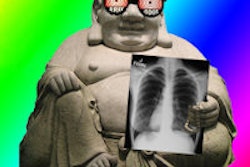
There are those doctors who go into radiology because they don't want to have much interaction with patients, but fortunately they are few and far between. Personally, I do like to talk with patients. Really.
But, frankly, I'm glad the opportunities are limited, because I don't think I have what it takes to handle a painful exchange, such as having to tell people they or a loved one has cancer. My mental health is far better served by talking to the PACS monitor. It only rarely talks back.
Many radiologists dread hearing from those we study, and here is one reason why: There is a new phenomenon out there of patients reading their own reports. I have written on Sermo.com (sorry, physicians only) and AuntMinnie.com in the Forums about what happens when angry patients get hold of this information.
Keep in mind that Obamacare mandates that patients have an electronic portal to their entire record, so we are only going to see more conflict and carnage as patients try to digest material we have spent a lifetime learning to understand.
With all that in mind ...
The other day, one of my nuclear technologists walked into my office and told me that a patient, whose PET/CT I had interpreted a week or so before, wanted to meet with me. She had read my report and needed to tell me about some things I hadn't mentioned. I assumed the worst and prepared myself for the inevitable confrontation with a belligerent, angry, undereducated, overmedicated, entitled member of the Me-First Society. How wrong I was.

The patient was ushered into my office, with my chief technologist in attendance. I reviewed the patient's scan with her, starting with the very basics ("A PET scan looks for areas that are using sugar more actively than other areas ..."). I then showed her the area of concern on the scan and suggested how this might be further evaluated.
Rather than becoming angry, she seemed more and more relieved -- and ultimately even tearful. But she was quite correct: I did not have the full story, not by a long shot.
To keep it short and simple, this patient had been worked up extensively in the past for an unusual malignancy. She was felt to be cured (and I still think she is).
For whatever reason, she had stopped seeing her oncologist and was now treated by her primary care physician. She had recently experienced some back pain, which led to an MRI. The MRI showed some odd findings, which led to the PET/CT. The PET/CT led to my stating that she had a different finding that was probably benign, but she would need another MRI of a different area to prove this.
With me so far? So was the patient. Who proceeded to tell me that she had had three prior PET/CT exams at the local outpatient facility.
Putting it all together in retrospect, the funny findings on the lumbar MRI (that maybe she needed) which prompted the PET/CT had been there for years and were benign. But now, the patient has gone through a PET/CT she really didn't need, and she will have another MRI that she really doesn't need -- all to prove that the artifact on the PET/CT she really didn't need is, indeed, an artifact.
The portable patient
I have railed for years and years about the need to accommodate the "portable patient," and in fact one of my old AuntMinnie.com articles from 2005 deals with this phenomenon:
Of the thousand daily frustrations I experience as a radiologist, perhaps the most painful is that of the "portable patient." You see, patients migrate from hospital to hospital, from clinic to clinic, and from office to office. They may be searching for a second opinion, a superspecialist, someone who will give them the particular answer they seek (some want to hear good news, some prefer bad news), convenience, drugs, or some combination of the above.
As often as not, they acquire a mountain of imaging studies along the way. When asked why they had a particular study at a particular site, the answer is invariably, "My doctor told me to have it there."
I've introduced you to a portable patient, and you can see what happened to her because no one knew about the examinations she had already undergone. She was irradiated, magnetized (probably less of a problem), and scared to death (arguably more damaging than radiation) because we have no way to connect the dots of her various studies.
Well, that isn't quite true. We do have ways -- we just aren't using them. My earlier articles, in their naïveté, proposed something akin to a regional health information organization (RHIO), which could serve as a repository for images no matter where they were obtained. You might think the Affordable Care Act mandates this in some form, but it really just pushes for electronic records, and the "meaningful abuse" provisions are simply there to bribe physicians to make their systems receptive to data pillaging by Washington, DC. But I digress.
The state of Maine has an image archive that serves as a repository for the studies of all its residents, according to an article from the American College of Radiology (ACR). Maine might be unique:
Most states would have difficulty implementing a statewide image archive because many providers are proprietary when it comes to patient data. But Maine is uniquely situated to make it work. That's because when HealthInfoNet was founded in 2006, the state's four primary healthcare organizations agreed not to compete over data, Rogow says [Todd Rogow, director of information technology for HealthInfoNet]. "There's a lot of respect among members," he says. "We've been able to keep everyone on board with exchanging their data, [in spite of the fact that] it's a voluntary structure."
Maine is also well-suited for the program because of its size. The state is geographically large but has only 1.3 million residents and 38 hospitals, which makes coordinating a statewide exchange more manageable than in heavily populated states like California and Texas.
But still, the Maine experience provides proof of concept. This can be done. Many years ago, when our old PACS needed replacing, I suggested to the IT types that the three hospital systems in our average town in the South combine efforts to create a single citywide PACS to serve all three hospitals and, particularly, all of their patients. I was told by the illustrious chief information officer that we couldn't even think of working with one of the other hospitals because it was "suing us" (which wasn't quite a lie ... they were challenging a certificate of need application). Millions of dollars and patient welfare down the toilet over C-suite egos.
There were and are other approaches. As an alternative to a central repository, connecting one PACS to another isn't that hard. The best way to do this -- and fulfill all HIPAA requirements in the process -- is to use an image-sharing system such as LifeImage (my personal favorite by a mile).
Don't even bother to suggest that CD-ROMs solve anything. They don't. They get lost, they get broken, they don't always load, the patient forgets to bring the disk, or the original imaging site forgets to send it, and darn, they're closed today ...
At one of the centers we staff, the clinicians come at me at least twice a day, every day, with an outside CD. After three years, I finally was able to convince the powers that be to load the damn things into PACS and merge the data with local exams. But the clinicians don't want to bother with waiting for the disks to load -- they want results now. In my opinion, CDs aren't even worthy of being drink coasters, given that huge hole in the middle.
My daughter Dolly, now a fourth-year medical student, suggests that patients themselves have some responsibility to inform us about prior exams, as my patient above did, though after the fact.
For better or worse, that is not going to work in most cases, and we all know why. Hold the patient responsible? In an ideal world, maybe. But it won't happen in my lifetime. And it's next to impossible for an overworked primary care doctor to know about every examination that has been ordered by the patient's army of physicians. To pervert the old saying, too many docs spoil the patient.
The portable patient is a problem with solutions that are not necessarily cheap. Still, they are necessary.
A simple solution
Here's where I'm going to anger a lot of people, and this is of course why you like to read my rantings. The following is something that needs to be said, however, and I'm going to say it.
Given that ...
- Not knowing that the patient has had prior studies leads to unnecessary imaging
- Unnecessary imaging may expose the patient to unnecessary radiation, costs, and anxiety
- Unnecessary radiation is bad for you, as is anxiety
- We have ways to share prior studies
... then it stands to reason that today, in the 21st century, shirking our responsibilities to the patient in this aspect of medical imaging is malpractice. Yes, I used the "M" word. But that's exactly what it is. We are not doing what we should -- and what we must -- for patient care. It is high time to apply technology that has been around for a long time to unify patients' records, imaging and otherwise.
We are harming our patients out of ignorance, out of hubris (why would they go to any doctor/hospital/clinic other than me/mine?), and out of greed (I get the revenue if I repeat the study!). This is completely unacceptable.
Let's all do something about it. Talk to the radiologists, the IT folks, the clinicians. The time has come to fix this very fixable problem.
And don't be afraid to talk to the patients. You might be one someday.



















